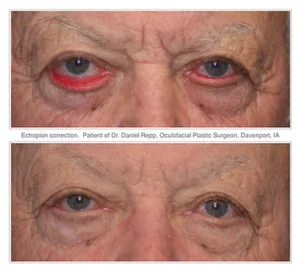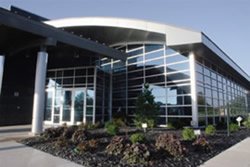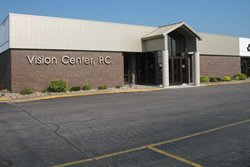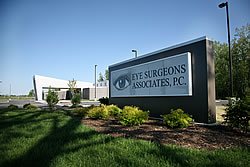What is entropion?
Entropion is when your eyelid turns inward, leading your eyelashes to scratch the surface of your eye. This commonly leads to constant eye irritation, redness and mucous in the eye. In some cases, the lashes can scrape the surface of the eye enough to put the eye at risk of an infection. Entropion commonly affects the lower eyelids, although occasionally an upper eyelid can roll inward too. To see before and after photos, scroll to the last bank of photos in our before & after gallery.
What is ectropion?
Ectropion is when your eyelid has a tendency to turn outward, potentially falling away from the eye. You may notice an increase in tearing from the eye if you have a mild ectropion, although you may not actually see the eyelid actually falling away from the eye. Ectropion is a common cause of tearing for many people, although tearing has many other possible causes.
Other people may notice their eyelid is so loose that it completely falls away from the surface of the eye. This type of severe ectropion is very bothersome, leading the mucous membrane on the back of the eyelid to turn extremely red as it dries out. Patients with this condition can also experience severe tearing, because the tear drain sits on the edge of the eyelid, at the inner corner. When the eyelid falls away from the eye, the tears cannot find their way into the tear drainage system, leading the tears to run onto the cheek. To see before and after photos, scroll to the last bank of photos in our before & after gallery.
Are there any conditions that occur along with ectropion?
Punctal stenosis is a condition that occasionally occurs as an eyelid rolls outward, as is the case in an ectropion. Punctal stenosis can also occur on its own. As noted above, the tear drain sits on the inner corner of the eyelids. The top portion of the drainage system is called the punctum, a structure that is similar to the open end of a pipe, because the punctum’s job is to collect tears. When an eyelid is out of position, the top portion of the tear drainage system becomes irritated. That irritation can cause the punctum to become scarred and narrowed. This can cause significant tearing, because narrowing of the punctum is similar to plugging the pipe in your sink. Correcting punctual stensosis is a surgical technique to widen the punctal opening. This technique is occasionally needed at the same time as an ectropion repair.
What are some common symptoms?
Tearing is a common problem caused by both entropion and ectropion. People often find that their eyes feel scratchy or irritated, because the eyelids are not properly gliding over the surface of the eyes to smooth their surface.
What causes the lid to roll inward or fall outward?
Several things contribute to the problem. Perhaps the single most important cause is looseness of the eyelids. In childhood, the eyelid has lots of elastic tissue, allowing the eyelid to spring back to the eye rapidly if it is pulled away. Think about this elastic tissue like a rubber band, anchored to the inner and outer corner of the eye socket. As time goes on, the eyelid loses its ability to spring back into place, making the eyelid unstable and prone to turning either in or out.
Another cause for an eyelid to roll out of position is the health of the connection between the eyelid and the muscles that pull it downward. Normally, when you look down to read, your lower eyelid glides down with the eye. This keeps the eyelid from blocking your vision when you are looking down. With time, the connection between the lower eyelid and its muscles can give way, leading to further eyelid instability.
Other factors can play a role in whether an eyelid rolls inward or out. But the above causes are the most common.
How does surgery work?
Surgery to correct an eyelid that turn inward or outward is typically an outpatient, or day surgery, allowing you to recover at home following surgery.
Surgery to treat an eyelid that rolls inward or outward is commonly done in an ambulatory surgery center. Dr. Repp will work with you to customize a plan to help keep you comfortable during surgery. Most patients receive medication to help maintain general comfort during the procedure (IV sedation). They will also get medication to anesthetize the eyelids.
Typically, Dr. Repp will make a small incision near the outer corner of the eyelid, allowing Dr. Repp to tighten the eyelid. There may also be an incision beneath the eyelashes of the lower eyelid or even inside of the eyelid.
Surgery corrects the factors forcing the eyelid out of position. If the eye falls outward, Dr. Repp can often correct the problem by simply tightening the eyelid through a small incision at the outer corner of the eye. You can think about this as similar to cinching up a belt. Surgery cannot restore you eyelid’s springiness, but tightening the eyelid can still improve or restore its position. Dr. Repp may address other problems at the same time, such as restoring the connection between the lower eyelid and the muscles that move the eyelid downward. This is often done during repair of an ehyelid that rolls inward (entropion).
After surgery, most patients will return home the same day for recovery.
Will surgery change the appearance of my eye?
Typically, surgery will not dramatically change your appearance. Usually, the surgery will not improve the appearance of lower eyelid bags, if you have them.
What about recovery and aftercare?
Each patient is unique, so Dr. Repp will customize an after-care plan for you, but some general guidelines follow. Ask Dr. Repp if these apply to you before following any of the recommendations on this site. And if something does not seem right, do not hesitate to call Dr. Repp.
Most patients will use frequent cool compresses for the first two days after surgery. During this time, Dr. Repp will likely ask you to limit activity, commonly recommending that you avoid any heavy lifting or bending. These activities can stress your surgery site and set back your healing. Following surgery, most patients experience only mild-to-moderate discomfort that can often be effectively treated at home with medications recommended by Dr. Repp. If you experience more than mild pain or discomfort, you should call Dr. Repp immediately for recommendations. You will also need regular ointment on your incision line and in the eye. The ointment acts as a salve, soothing the incision as it heals. Many patients wonder when they can safely return to work or other normal activities. There is no single answer for every patient, so ask Dr. Repp for details. Lastly, Dr. Repp will place sutures during your surgery. These often dissolve between one-to-two weeks following surgery. Ask Dr. Repp for details.





